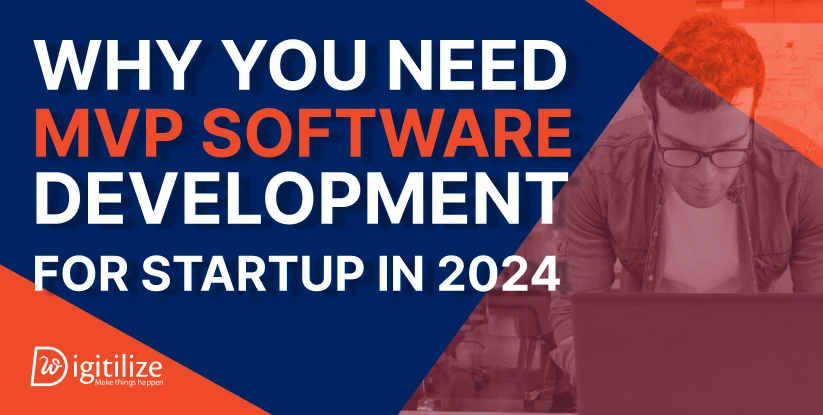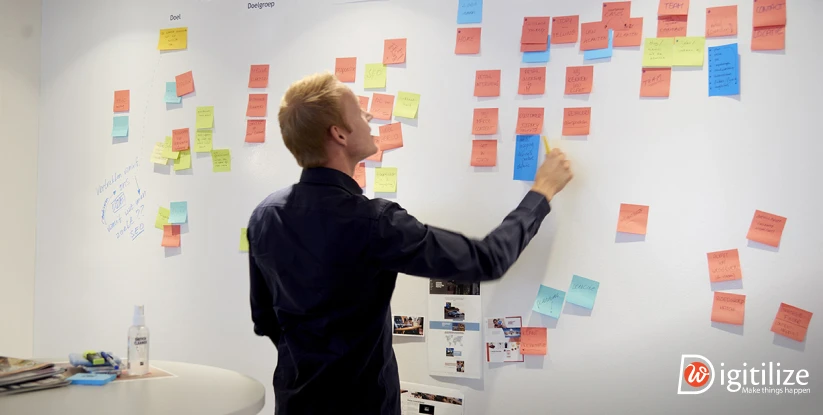Why You Need MVP Software Development for Startup in 2024
 In the quick-paced world of technology, MVP development is an essential tactic for startups. Particularly for those looking to turn creative concepts into profitable products. So, know the reason why you need MVP software development for startup in 2024. This startup growth strategy 2024 tackles a prevalent issue in the ever-changing digital world of today.
Startups can achieve better success by testing, refining, and testing their ideas through the creation of basic versions of their goods. MVP development methodologies for startups are still relatively unknown, despite their ability to assist small enterprises in testing concepts before completely creating them. This blog will examine how entrepreneurs may more effectively present new ideas to the market by combining simplicity and strategy with MVPs.
In the quick-paced world of technology, MVP development is an essential tactic for startups. Particularly for those looking to turn creative concepts into profitable products. So, know the reason why you need MVP software development for startup in 2024. This startup growth strategy 2024 tackles a prevalent issue in the ever-changing digital world of today.
Startups can achieve better success by testing, refining, and testing their ideas through the creation of basic versions of their goods. MVP development methodologies for startups are still relatively unknown, despite their ability to assist small enterprises in testing concepts before completely creating them. This blog will examine how entrepreneurs may more effectively present new ideas to the market by combining simplicity and strategy with MVPs.
Why you need MVP software development for startup in 2024
It is crucial to first understand why MVP development is necessary for entrepreneurs. In their quest to thrive in the competitive business environment, many entrepreneurs view MVPs as their secret weapon. Let’s explore the key benefits of developing an MVP for a startup.
Building an MVP helps you save money right from the start. You focus only on the features that matter most. Everything else can wait. This way, you avoid spending on things that aren’t essential yet. It’s a smart way to manage your budget.
MVP software development for startup in 2024 is all about using fewer resources. From design to development, you build only what’s needed to test your idea. You don’t waste money on a full product that may not work in the market.
Think of an MVP as your safety belt. It keeps you from overspending on a product that hasn’t been tested. By starting small, you reduce the risk of failure.
If the MVP doesn’t work, you still gain something valuable—real market insight. And you avoid losing a big budget. That’s the power of MVP development. It helps you stay lean, learn fast, and grow wisely.
-
Formulating a practical resolution
A minimal viable product, to put it simply, is an extremely basic, feature-limited version of a product validation for startups that will nevertheless function. It can be designs fast and inexpensively, much like a rapid prototyping for startups, but it needs to be well-made, flawless, and visually appealing. This is why you need MVP software development for startups in 2024.
Prototypes, demos, and false doors are just a few of the tools you might use to evaluate the viability of your concept. It must address a user’s issue, though, in order to qualify as a true MVP. The plan is to analyse the data, make adjustments, and improve the product little by bit. For startups, the iterative process of developing an MVP promotes continuous improvement based on user input.
-
Accelerating the introduction of a product
 Realise that a competitor may introduce a comparable product before you. Becoming the first player in the market might work in your favor because the industry evolves swiftly. This is why you need MVP software development for startup in 2024.
The creation of an MVP has other advantages. It enables businesses to introduce their products more quickly and get them into the hands of customers sooner. Thus, this strategy has helped a lot of prosperous businesses who decide to offer a beta version of their product rather than waiting to develop a full solution. Teams may get feedback more quickly by shortening the time it takes to launch a product. Better development decisions result from this aiding in decision-making.
Realise that a competitor may introduce a comparable product before you. Becoming the first player in the market might work in your favor because the industry evolves swiftly. This is why you need MVP software development for startup in 2024.
The creation of an MVP has other advantages. It enables businesses to introduce their products more quickly and get them into the hands of customers sooner. Thus, this strategy has helped a lot of prosperous businesses who decide to offer a beta version of their product rather than waiting to develop a full solution. Teams may get feedback more quickly by shortening the time it takes to launch a product. Better development decisions result from this aiding in decision-making.
-
Well-defined value proposition and superior merchandise
In summary, the MVP becomes something customers like when teams concentrate on finding a solution to a particular issue. Even a basic yet well-made product that fixes a basic issue is valued when it addresses customers’ primary concerns, which contributes to the MVP’s success.
To produce a top-notch product, the team requires the right information and resources. That’s why a lot of large corporations and startups go to MVP development companies with knowledgeable teams for assistance. This is why you need MVP software development for startup in 2024.
A well-aligned minimal viable product’s core can gradually develop into a larger and more comprehensive version, similar to a minimum lovable product, highlighting the advantages of MVPs. It can adjust to shifting consumer preferences and early market testing conditions.
-
Distributing teamwork as efficiently as possible
The prudent use of resources is greatly aided by a well-considered approach to the Minimum Viable Product development launch. Teams can optimise their time by focusing on the most crucial aspects and delaying the less significant elements until later. Thus, this is why you need MVP software development for startup in 2024.
Spending less money on unnecessary features is made possible by this attention to feature selection. It implies that teams save time by not developing pointless features. The business spends money on salaries and other resources more wisely. These are undoubtedly important advantages of creating an MVP.
-
Testing theories and concepts
An MVP lets you test your idea without spending too much at the start. It helps you check if there’s real market demand. You can also learn about your target audience, your key selling points, and the strength of your business idea.
It also gives insight into pricing, marketing strategies, must-have features, and design choices. With MVP software development for startup in 2024, you can gather real feedback through different testing methods. You’ll know if people actually want your product.
You can also spot bugs or issues and fix them early. In short, an MVP is the fastest way to see if your idea will work in the market.
Evaluating comments to make wise judgments
Launching an MVP helps you attract early adopters. These users love testing new products and sharing their thoughts. They can turn into loyal fans who give real feedback and tell others about your product. That’s one big reason why MVP software development for startup in 2024 is so important.
With an MVP, you can launch faster. Your team can learn from real data, not just guesses. Maybe something you believed was wrong. Maybe your business model needs a change. This kind of insight helps you improve. It also builds trust and brings in more users.
-
Growing prospects for outside finance
 In actuality, since so many people are looking for financial help, raising money for your product or business might be difficult. Consequently, you should consider your options for funding, particularly in the beginning. Thus, the secret is to have a working MVP to get confidence. Therefore, this is why you need MVP software development for startup in 2024.
Having a physical product, especially in its early stages, boosts your chances of success when you present your idea. Teams who can demonstrate a viable solution gaining traction are more likely to be taken into consideration by investor attraction with MVP and venture capitalists. Investors could find it too risky to hear about an idea from you if you are not offering a physical product. It is essential to convince them by offering openness and statistics to back up your proposal.
In actuality, since so many people are looking for financial help, raising money for your product or business might be difficult. Consequently, you should consider your options for funding, particularly in the beginning. Thus, the secret is to have a working MVP to get confidence. Therefore, this is why you need MVP software development for startup in 2024.
Having a physical product, especially in its early stages, boosts your chances of success when you present your idea. Teams who can demonstrate a viable solution gaining traction are more likely to be taken into consideration by investor attraction with MVP and venture capitalists. Investors could find it too risky to hear about an idea from you if you are not offering a physical product. It is essential to convince them by offering openness and statistics to back up your proposal.
In 2024, How Much Will It Cost to Develop an MVP?
Let’s get straight to the point, how much does it cost to build an MVP in 2024? This is where your ideas turn into actual numbers and budgets. It’s a crucial step to make sure your project stays financially healthy.
For startups in 2024, knowing the cost of MVP software development is key. The final cost depends on two main things: the type of MVP you choose and how you decide to build it. Different approaches lead to different price tags.
Now, let’s break down the cost for each type of MVP.
With an approximate cost of $13,000, hiring freelancers might be a financially advantageous choice. So, this option could offer flexibility to low-budget enterprises, but the final result will rely on the expertise and abilities of the freelancer.
The average cost of developing an MVP with an internal team is $25,000. There is more control and direct interaction, but overhead and wage costs go up.
The creation of an MVP may cost up to $65,000 from local agencies. They frequently offer high-quality, in-person communication and have a thorough awareness of the local market in addition to being seasoned experts.
This option can save up to $35,000 and provide you access to a larger pool of talented candidates at a reduced price.
-
MVPs in software or mobile apps
Building mobile applications or working software with a small feature set is the goal of these MVP kinds. The cost often falls between $15,000 to $50,000, depending on the intricacy of the project and the rates of the development team.
Factors Affecting MVP Prices

-
Platform and stack of technologies
The cost of developing an MVP in 2024 is mostly dependent on the platform and technology stack selection. So, startups must be aware of the technologies they choose since they have an immediate effect on the costs and duration of development.
Cost reductions can result from choosing the appropriate technology stack. For example, because open-source technologies are openly accessible and have a developer community that supports them, they frequently result in lower development costs. Selecting the platform is crucial as well; the cost is impacted by selecting web-based, mobile, or cross-platform development. Cross-platform development technologies, like React Native or Flutter, can save expenses by enabling the development of iOS and Android apps from a single codebase.
-
Characteristics and intricacy
The intricacy of the features you wish to include will also have a big influence on how much constructing an MVP in 2024 will cost. The cost of development will go up if you desire to add more features and functionalities.
Startups frequently struggle with the desire to produce an MVP that has every feature imaginable. Thus, incorporating an excessive number of features may result in higher development costs and development timeframes.
Startups should prioritise key features and functionality to control costs. So, you may offer a working and user-friendly MVP while controlling expenses by concentrating on the most important elements.
-
User experience and design
In 2024, the cost-effective software solutions of building an MVP will be mostly determined by its design and user experience. Although a well-designed MVP might draw in users and make a first impression, it can also raise the total cost of development.
It frequently takes more time and resources to create a visually appealing design and a flawless user experience. Expenses may increase if your MVP calls for complicated user interfaces, bespoke graphics, or complex visual aspects. Nevertheless, in order to attract customers and obtain valuable feedback, these design components are essential. Hence, the issue is striking a balance between the necessity of an eye-catching design and financial constraints. To cut money on design, startups might choose to use UI kits or pre-designed templates.
In conclusion, the agile development for startups may significantly impact companies by utilising the minimal viable product strategy. It’s a wise approach to learn from consumers, lower risks, and expedite development—it’s not just about saving money.
More than anything, MVP software development builds a mindset of constant growth. Your team learns something new with each version of the product. This keeps you moving forward. It helps you improve faster and sets the stage for long-term success.
At DigitilizeWeb, we focus on building strong and reliable MVPs. Want to see how we turn ideas into real, market-ready products? Check out our portfolio and get in touch with us today. Let’s build something great together. To read more such content follow us on LinkedIn.
Frequently Asked Questions
Startups can control costs by prioritizing key features, choosing appropriate technology stacks, focusing on user experience design without overcomplicating it, and avoiding unnecessary feature additions that can inflate development costs.
Startups can use techniques such as beta testing with early adopters, collecting user surveys, analyzing user behavior data, conducting A/B testing, and monitoring customer support interactions to gather feedback on their MVP.
Having a working MVP demonstrates to investors that the startup has a viable product idea with potential market demand. Startups can use data and user feedback from the MVP to showcase traction and validate their business model, increasing their chances of securing funding.
MVP software development fosters a culture of continuous improvement, allowing startups to adapt and evolve their product based on ongoing feedback and market changes, thus increasing their chances of long-term success.
By creating a basic version of the product quickly, startups can enter the market sooner, gather feedback from early adopters, and make iterative improvements based on that feedback, thus accelerating the product launch process.
Factors such as the platform and technology stack chosen, the complexity of features, user experience design, and the development method (freelancers, internal team, agency, or outsourcing) can significantly impact the cost of developing an MVP in 2024.
 In the quick-paced world of technology, MVP development is an essential tactic for startups. Particularly for those looking to turn creative concepts into profitable products. So, know the reason why you need MVP software development for startup in 2024. This startup growth strategy 2024 tackles a prevalent issue in the ever-changing digital world of today.
Startups can achieve better success by testing, refining, and testing their ideas through the creation of basic versions of their goods. MVP development methodologies for startups are still relatively unknown, despite their ability to assist small enterprises in testing concepts before completely creating them. This blog will examine how entrepreneurs may more effectively present new ideas to the market by combining simplicity and strategy with MVPs.
In the quick-paced world of technology, MVP development is an essential tactic for startups. Particularly for those looking to turn creative concepts into profitable products. So, know the reason why you need MVP software development for startup in 2024. This startup growth strategy 2024 tackles a prevalent issue in the ever-changing digital world of today.
Startups can achieve better success by testing, refining, and testing their ideas through the creation of basic versions of their goods. MVP development methodologies for startups are still relatively unknown, despite their ability to assist small enterprises in testing concepts before completely creating them. This blog will examine how entrepreneurs may more effectively present new ideas to the market by combining simplicity and strategy with MVPs.
 Realise that a competitor may introduce a comparable product before you. Becoming the first player in the market might work in your favor because the industry evolves swiftly. This is why you need MVP software development for startup in 2024.
The creation of an MVP has other advantages. It enables businesses to introduce their products more quickly and get them into the hands of customers sooner. Thus, this strategy has helped a lot of prosperous businesses who decide to offer a beta version of their product rather than waiting to develop a full solution. Teams may get feedback more quickly by shortening the time it takes to launch a product. Better development decisions result from this aiding in decision-making.
Realise that a competitor may introduce a comparable product before you. Becoming the first player in the market might work in your favor because the industry evolves swiftly. This is why you need MVP software development for startup in 2024.
The creation of an MVP has other advantages. It enables businesses to introduce their products more quickly and get them into the hands of customers sooner. Thus, this strategy has helped a lot of prosperous businesses who decide to offer a beta version of their product rather than waiting to develop a full solution. Teams may get feedback more quickly by shortening the time it takes to launch a product. Better development decisions result from this aiding in decision-making.
 In actuality, since so many people are looking for financial help, raising money for your product or business might be difficult. Consequently, you should consider your options for funding, particularly in the beginning. Thus, the secret is to have a working MVP to get confidence. Therefore, this is why you need MVP software development for startup in 2024.
Having a physical product, especially in its early stages, boosts your chances of success when you present your idea. Teams who can demonstrate a viable solution gaining traction are more likely to be taken into consideration by investor attraction with MVP and venture capitalists. Investors could find it too risky to hear about an idea from you if you are not offering a physical product. It is essential to convince them by offering openness and statistics to back up your proposal.
In actuality, since so many people are looking for financial help, raising money for your product or business might be difficult. Consequently, you should consider your options for funding, particularly in the beginning. Thus, the secret is to have a working MVP to get confidence. Therefore, this is why you need MVP software development for startup in 2024.
Having a physical product, especially in its early stages, boosts your chances of success when you present your idea. Teams who can demonstrate a viable solution gaining traction are more likely to be taken into consideration by investor attraction with MVP and venture capitalists. Investors could find it too risky to hear about an idea from you if you are not offering a physical product. It is essential to convince them by offering openness and statistics to back up your proposal.


